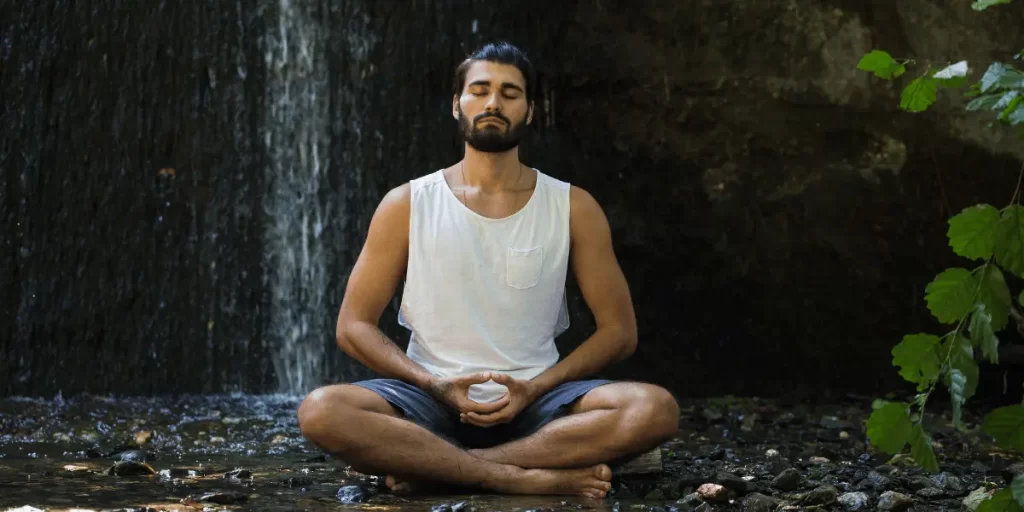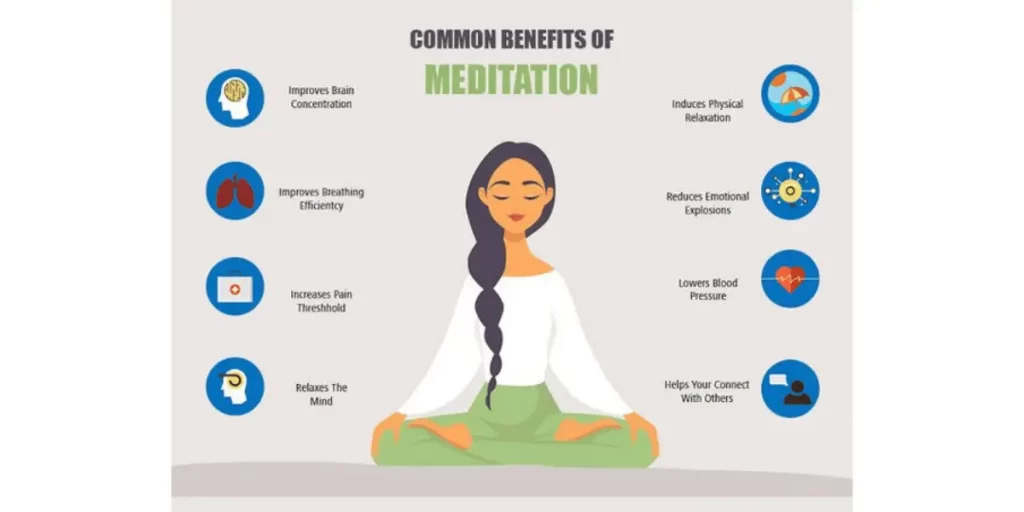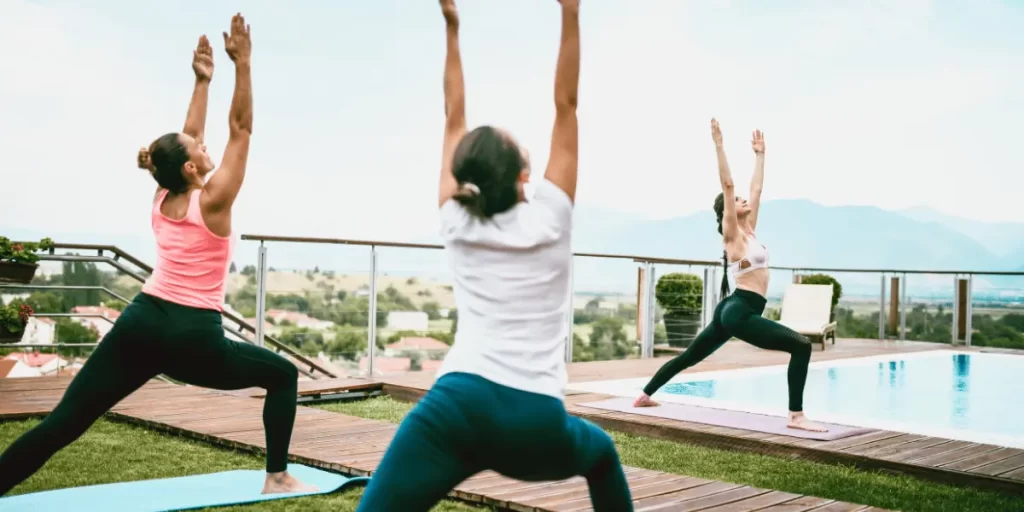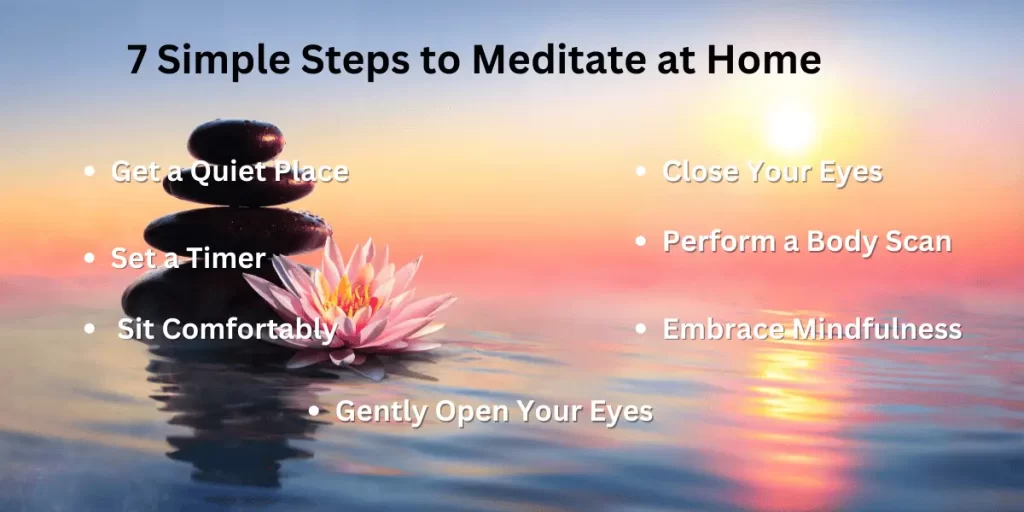Meditation is not something supernatural. It is actually an easy practice that helps you pause for a moment and calm down. In this blog post, learn how to do simple meditation at home in just 7 steps.
Understanding Meditation: A Brief Overview

Meditation has been around for centuries. Yet, it’s still taking over the world. This is not a surprise, though, since scientific studies have revealed its benefit on the brain and overall wellbeing.
What is meditation?
Meditation is a simple practice that makes you focus your mind on the present moment. It combines mental and physical technique to clear your mind of its racing thoughts. Different meditation techniques are turning up and with the use of modern technology, the benefits of these forms of meditation have become known.
The science behind meditation: Facts and figures
Neuroscience research reports that meditation can lessen inflammatory responses in people who experience stress. In other words, it can lower stress levels and anxiety. In addition, it can reduce mind-wandering. It can also enhance your ability to solve problems.
Furthermore, it can reduce activity in our amygdala and make us less reactive to stressful situations and also speed up the recovery process. Seasoned meditators benefit from meditation because such practice calms the brain’s default network, thereby leading to less rumination on one’s thoughts and feelings.
Scientific research has also reported that regular meditation practice can lead to the brain’s neuroplasticity. That is, it can alter structural changes and patterns in the brain (in a positive way). Additionally, it is proven that this practice can enhance the quality of sleep by some 10%.
Benefits of Meditation for Beginners

Research has linked meditation with a lot of short-term and long-term benefits. No wonder tons of people are incorporating it into their lifestyle. The physical and mental health benefits of this ancient practice are as follows:
Physical health improvements
Evidence suggests that meditation practice can help one manage chronic pain by changing the perception in the brain. Aside from that, it can also improve sleep quality and can even be used to treat sleep-related issues.
Mental health improvements
Meditation helps us manage our emotions well. Symptoms of stress, anxiety and depression are kept at a minimum level. Additionally, it can ease your mind and regulate your mood. No more ruminating about the past or worrying about the future. Meditation encourages the improvement of cognitive abilities.
Statistical evidence of meditation’s impact
53% of people who meditate mention it helps them improve their memory and concentration. There is also evidence that the practice reduces insomnia by almost 50%. Post-traumatic stress disorder is also reduced by as much as 70% in persons who meditate. Just four days of mindfulness meditation can reduce your anxiety.
Students who meditate also discover that it improves their school work and their energy. Research and various studies also report that 80% of people who meditate say it helps them with lower blood pressure and the management of heart attacks.
Getting Started: Essential Tips for Beginners

Many people are scared and confused when they are about to start meditation. Well, they don’t have to be. It’s important to start with these few tips so you can love the experience.
Creating a meditation-friendly environment
The first thing is finding or creating a suitable environment for meditation. While seasoned meditators can meditate in noisy places, beginners may not be able to do so. So, keep your space free from unwanted noise. You can listen to calm music during your practice.
Choosing the right time to meditate
If you’re a morning person, then you can practice in the morning. Otherwise, you can try other times of the day. Perhaps during your lunch break or in the evening before you go back to bed. There is no particular right time of day to meditate, just the one right for you. So, explore different times and stick to the one that works with your lifestyle.
Selecting comfortable clothing and posture
Put on comfortable clothing – something loosed and unrestrictive. It is best to take off your shoes or any accessory that may hinder the effect of the practice.
Regarding posture, sit up straight and relax your shoulders. The use of a meditation cushion can help you feel more comfortable during your practice.
7 Simple Steps to Meditate at Home

Let’s now give attention to how to do simple meditation at home in 7 simple steps.
Step 1: Get a quiet place
Find a quiet and peaceful place. It has been studied that a quiet place can naturally curb stress. It can also enhance focus and relaxation.
Step 2: Set a timer
As a beginner, setting a time limit is crucial to your practice. You should choose a short time like 5 or 10 minutes. Short meditation sessions can also have a profound effect on your health.
Step 3: Sit comfortably
Get seated comfortably and keep your back straight. You can sit in a chair or on the floor (with the cross-legged style). Feel free to make use of a yoga mat or bench. Just ensure your spine is aligned so you can breathe deeply and easily. Is it fine if I kneel? Is it fine if I stand? Is it fine if I lie? It’s okay, do whatever you want.
Step 4: Close your eyes
To help you focus on the present moment, you need to keep your eyes shut. You can reduce stress when you focus on your breath. So, do this: inhale and exhale. Next, concentrate. Then, notice your breath sensations.
Step 5: Perform a body scan
Scan your entire body and focus your attention on your breath while at it. The next thing is to bring your attention to all your body parts. Detect areas of tension and set them free. If there are any mental distractions, allow them to pass without judgment. Then, concentrate again on your breath.
Step 6: Embrace mindfulness
Mindfulness activates your consciousness of the present moment. Embrace mindfulness by perceiving your environment carefully. This will help you become deeply connected with your body.
Step 7: Gently open your eyes
When you’ve done the six steps, you can open your eyes. Do this gently and gradually. perform a few gentle stretches so you can experience a sense of calm. Then you can go about enjoying your day.
How to Overcome Common Meditation Challenges
It is true that meditation is good. Still, some people may face challenges that scare them from committing. We’re here to address such problems:
Dealing with a wandering mind
It’s okay if your mind wanders. After all, the goal of meditation is not to get rid of all your thoughts. When any thought pops up, turn to your mind and try to bring it back to the present.
Still, finding it hard? You can try breath meditation so that your mind will not easily stray. Other things you can do is repeating positive affirmations to yourself or paying full attention to music.
Managing distractions
Recognize the existence of distractions but do not get caught up in it. Just simply acknowledge and let them go. You can give the distraction a name and claim it. Use your breath as an anchor and bring your mind back to the breath when distractions occur.
Staying consistent with your practice
A busy person may forget it is time to meditate. Or results that are not yet obvious may push you out of the practice. So, make this practice part of your daily routine. Create a to-do list so you do not miss a day. Find yourself an accountability partner who can motivate you.
It will also be helpful if you can explore different types of meditation. Give yourself a pat on the back for every small achievement. Additionally, approach the practice of meditation with an open mind. Reduce or if possible, let go of any expectations. This experience is a journey and if you just follow the process, you will definitely enjoy it.
Guided Meditation: A Beginner’s Sure Help
First-timers can make good use of guided meditation. If you’re a beginner, it will provide a focal point and help you connect deeply with yourself.
Benefits of guided meditation
The field of science has undergone extensive research to reveal the amazing benefits of guided meditation. And we’re not going to let that slide.
- Research has stated that guided meditation can reduce stress disorders in people.
- It can also give you freedom from negativities and limiting beliefs.
- You can start meditating easily when you use guided meditation.
- A step-by-step guided meditation process helps you become fully immersed in the present moment.
- Like the general meditation practice, guided meditation improves relationships and cognitive abilities.
- It reduces the occurrence of negative thoughts that may want to ruin your day.
- Distractions are brought to a minimum when you employ the use of guided meditation.
- It also reduces loneliness especially if you can hear the soothing voice of the one guiding you.
- There will be a balance in your work life as well as a boost in creativity and sleep quality.
- Guided meditation can also help to boost attention span and memory skills.
Top apps and resources for guided sessions
- Meditation Apps: Headspace and Insight Timer are good examples of apps that can serve as guides. They have transcripts and sessions that are led by meditation teachers.
- Podcasts: Meditation Podcasts are helpful as they are with you everywhere you go. All you need is your cell phone (you can do without the internet if it’s already downloaded). The Daily Meditation Podcast is a good example that can help you. It has short sessions and a variety of techniques for your exploration.
- Videos: Subscribe to YouTube Channels like The Omega’s Institute to get access to a variety of meditations in a short time.
- Meditation Music: Acoustic guitar music and live streams are a good way to help you stay committed.
- Meditative Nature Sounds: Nature sounds can also serve as a meditation vehicle. The song of birds, the crashing of ocean waves, or the waterfall in the rainforest are all examples of nature sounds to help us with our practice.
Advancing Your Practice: Next Steps
Of course, you won’t be a beginner forever. Sooner or later, you may want to level up. But, how can you practice for longer sessions or go deeper into it? No worries, we’ve got that covered.
Exploring different meditation techniques
In an attempt to advance your practice, you may want to try out new meditation techniques. If you find any that suits you, give it a try. If you enjoy it, stick to it. This will help you become more committed to the practice.
Advanced techniques you can explore include body scan, progressive muscle relaxation, visualization and mantra.
Gradually increasing session duration
Yes, you started with meditation for just 5 minutes (or less). Taking your practice to the next level means you need to increase that. But you don’t have to make it sudden. Advancing your practice takes time so be patient. You can start by adding one minute each week till you reach your desired time. As you get deep into your routine, you can do yourself a favor by learning about other meditation techniques.
Joining meditation groups or classes
While solo meditation is not bad, meditating in group is a lot better. Finding people who like to meditate and who would motivate you is one of the best supports ever. So, join meditation groups and classes; reach out to fellow meditators or yogis who also want to elevate their meditation experience.
Seek out gurus who can guide you. These people can boost your connection and sense of commitment to the practice.
Conclusion: Embracing the Journey of Meditation
The meditation journey is a path that will transform your life for good. It can lead to spiritual harmony and tranquility. When you take out the time to infuse this practice in your daily routine, you are sure to get the reward.
Recap of key points
This blog post has extensively covered how to do simple meditation at home. You can do so in 7 simple steps which include creating your environment, setting a timer and staying in a comfortable position. It is also beneficial if you can focus on your breath and ignore the distractions because definitely, your mind will wander.
We have also talked about the benefits of meditation on your physical and mental health. And if you are lost, there are apps and resources to help you find your way and stay on it.
Encouragement for continued practice
It requires patience and consistency to embrace the journey of meditation. So please, don’t give up even when it seems you’re not doing it right. Keep pushing and you will be leading yourself to a more clarified and joyful life.
Frequently Asked Questions(FAQ’s)
Do simple steps like (i) closing your eyes (ii) breathing in and out (iii) relax
i. focus on your breathing ii. use your mind’s eye which is same as visualization or guided imagery iii. practice mindful walking and use your senses to feel your environment iv. fix your gaze on an object of focus v. perform body scan or progressive relaxation
Yes, it does and that is showing up for practice. Showing commitment every day is crucial.
Start small with just 5 – 20 minutes. As you develop your meditating skills, you can increase the time.
According to experts, the time varies. However, the ideal time is between 5 and 45 minutes.
Yes, that time is enough to give you the changes you need.
When you’ve settled down, close your eyes. Breathe deeply and observe your body sensations. Allow your mind to be free and then you can open your eyes.
First ensure you have a quiet corner at home. You can then incorporate yoga poses to help you relax.
This could be due to your past trauma or negative experiences. These emotions are unprocessed, you just have to acknowledge and let go.



